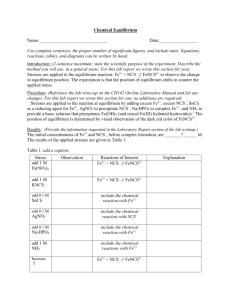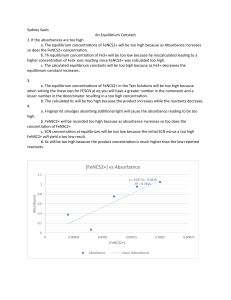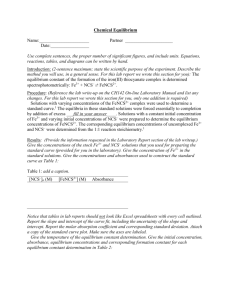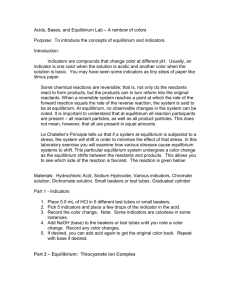Experiment 7: Report form
advertisement
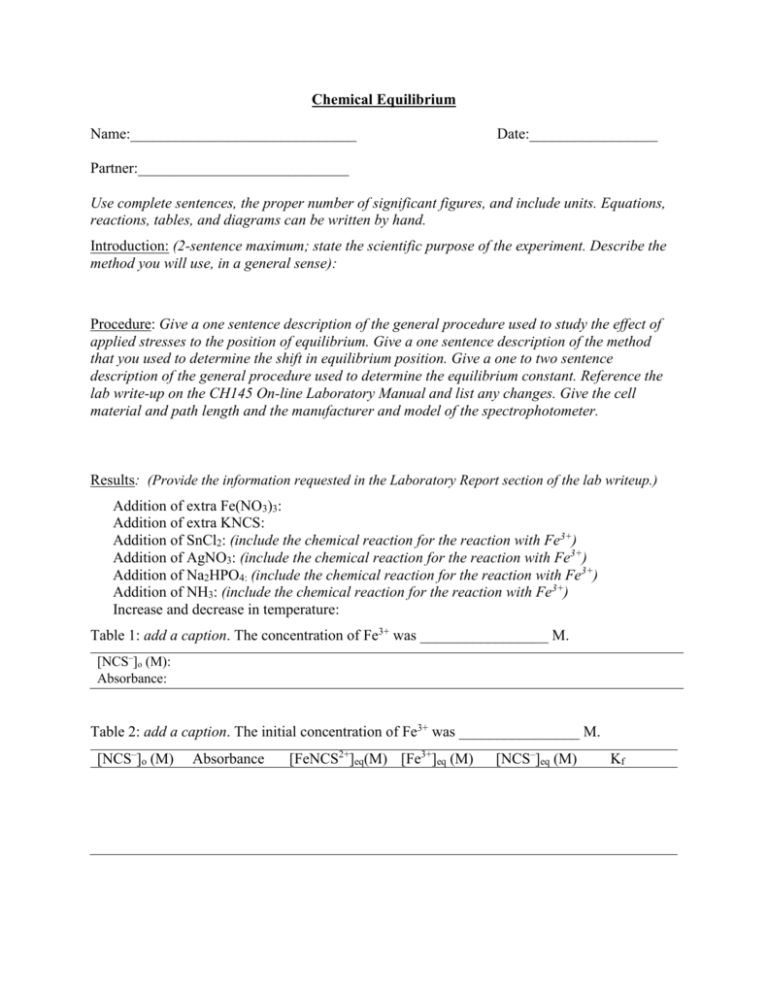
Chemical Equilibrium Name:______________________________ Date:_________________ Partner:____________________________ Use complete sentences, the proper number of significant figures, and include units. Equations, reactions, tables, and diagrams can be written by hand. Introduction: (2-sentence maximum; state the scientific purpose of the experiment. Describe the method you will use, in a general sense): Procedure: Give a one sentence description of the general procedure used to study the effect of applied stresses to the position of equilibrium. Give a one sentence description of the method that you used to determine the shift in equilibrium position. Give a one to two sentence description of the general procedure used to determine the equilibrium constant. Reference the lab write-up on the CH145 On-line Laboratory Manual and list any changes. Give the cell material and path length and the manufacturer and model of the spectrophotometer. Results: (Provide the information requested in the Laboratory Report section of the lab writeup.) Addition of extra Fe(NO3)3: Addition of extra KNCS: Addition of SnCl2: (include the chemical reaction for the reaction with Fe3+) Addition of AgNO3: (include the chemical reaction for the reaction with Fe3+) Addition of Na2HPO4: (include the chemical reaction for the reaction with Fe3+) Addition of NH3: (include the chemical reaction for the reaction with Fe3+) Increase and decrease in temperature: Table 1: add a caption. The concentration of Fe3+ was _________________ M. [NCS–]o (M): Absorbance: Table 2: add a caption. The initial concentration of Fe3+ was ________________ M. [NCS–]o (M) Absorbance [FeNCS2+]eq(M) [Fe3+]eq (M) [NCS–]eq (M) Kf Discussion: (a). Purpose accomplished: Restate the purpose of the experiment, but as completed goal. (b). Write the reaction that you are studying. (c). Give a general summary statement about the agreement between the observed shifts of the position of equilibrium and the predictions based on LeChatelier’s principle. (d). For the determination of the standard curve, discuss how the position of equilibrium was shifted to allow the concentration of the FeNCS2+ ion to be calculated from the reaction stoichiometry. (e). Give the average and standard deviation for the formation equilibrium constant. Call this standard deviation the observed standard deviation. (f). Consider the effect of random and systematic errors. (i). Use the number of significant figures in the molar absorption coefficient to predict the expected number of significant figures in the formation constant. Compare this expected number of significant figures to the observed standard deviation. There are two possibilities for this comparison (choose one): (1). If the expected number of significant figures, as predicted from the uncertainty in the molar absorption coefficient, is consistent with the observed standard deviation then draw a conclusion about the predominant source of random error. (2). If the expected number of significant figures is not consistent with the observed standard deviation, give a likely additional source of random error. (ii). Suggest a source of systematic error. Remember that student mistakes are neither random nor systematic errors; student mistakes are just student mistakes. What effect does the source of systematic error have on the final results? (For example, does the systematic error cause curvature in the standard curve or increase or decrease the value determined for the formation constant?) (g). To summarize the experiment answer the following questions: (i). Note that the initial conditions for the different equilibrium measurements vary significantly in your report Table 2. Observe the values for the individual formation constants. Use the data in Table 2 to explain, in words in a general sense, the relationship between the initial conditions and the formation constant. In other words, what is the meaning of an equilibrium constant? (ii). How can we control the outcome of chemical reactions at equilibrium? Literature Cited: (Give all literature cited, numbered according to the references in the body of your report.) Attach the standard curve. Attach your data tables if they are not included in the bulk of the Report. Checklist: Use complete sentences and provide the proper number of significant figures and units. All Figures and Tables must have captions. Refer by number to each figure and table in the body of the text or your report. Acknowledge any data that were not taken by you and your partner (if you had a partner). Captions start with Figure # or Table # and then a concise description of the contents. You can write the captions by hand in black pen on attached sheets. Answer all the questions in the Discussion section of the write-up. Remove all the italicized prompts in your final report. The report should then read smoothly.
